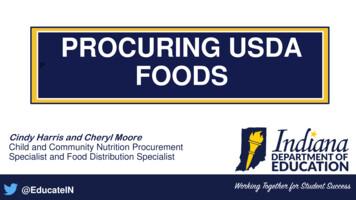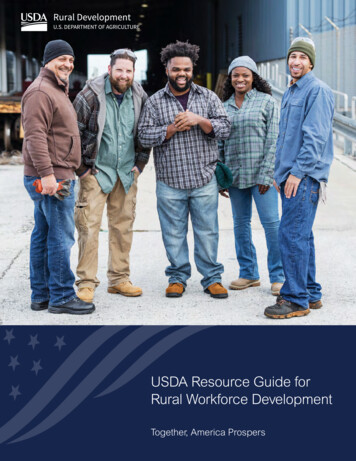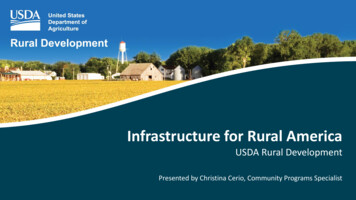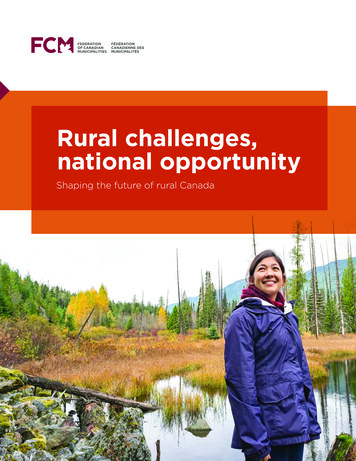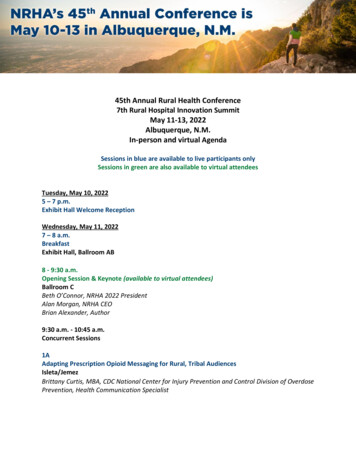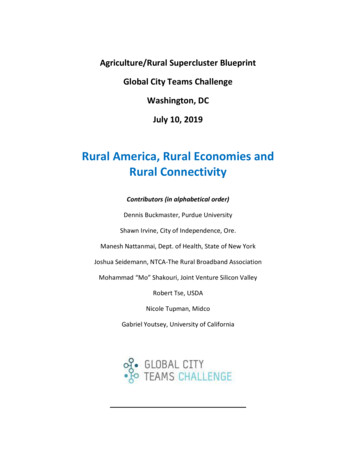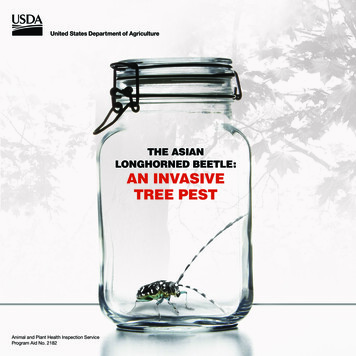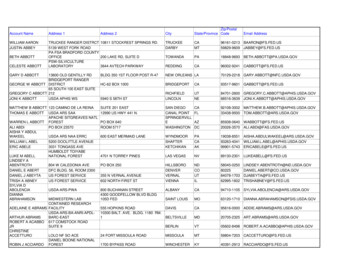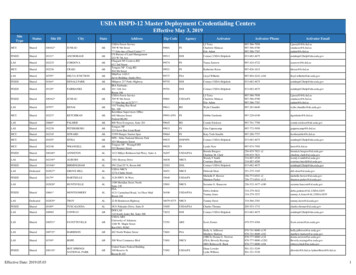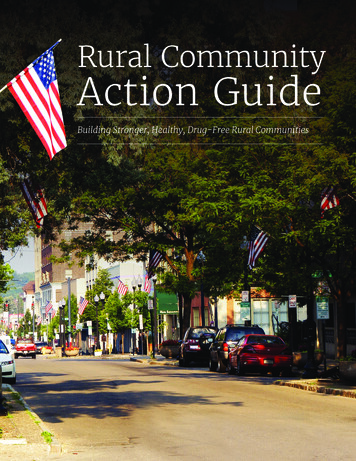
Transcription
Rural CommunityAction GuideBuilding Stronger, Healthy, Drug-Free Rural Communities
Inside Front Cover
Table of Contents3Table of ContentsLetter from ONDCP Director, James W. Carroll . . . . . . . . . . . . . . . . . . . . . . . . . . . . . . . . . . . . . . . . . . . 6Letter from ONDCP Senior Advisor for Rural Affairs, Anne C. Hazlett. . . . . . . . . . . . . . . . . . . . . . . . . 7Abbreviations . . . . . . . . . . . . . . . . . . . . . . . . . . . . . . . . . . . . . . . . . . . . . . . . . . . . . . . . . . . . . . . . . . . . . . 8Glossary of Terms . . . . . . . . . . . . . . . . . . . . . . . . . . . . . . . . . . . . . . . . . . . . . . . . . . . . . . . . . . . . . . . . . . . 9Introduction. . . . . . . . . . . . . . . . . . . . . . . . . . . . . . . . . . . . . . . . . . . . . . . . . . . . . . . . . . . . . . . . . . . . . . .11SECTION 1: Face of Addiction. . . . . . . . . . . . . . . . . . . . . . . . . . . . . . . . . . . . . . . . . . . . . . . . . . . . . . . . . 13The Changing Face of Addiction. . . . . . . . . . . . . . . . . . . . . . . . . . . . . . . . . . . . . . . . . . . . . . . . . . . . . . . . . . . . . 14Moving Beyond Stigma in Rural Communities by Addiction Policy Forum. . . . . . . . . . . . . . . . . . . . . . . 16Using Data to Better Understand Substance Use Disorder and Opioid Use Disorderby NORC Walsh Center for Rural Health Analysis . . . . . . . . . . . . . . . . . . . . . . . . . . . . . . . . . . . . . . . . . . . . . . 20SECTION 2: Impact of Addiction on a Rural Community. . . . . . . . . . . . . . . . . . . . . . . . . . . . . . . . . . . 23Managing the Push and Pull on Fiscal Resources during the Opioid Crisisby National Association of Counties. . . . . . . . . . . . . . . . . . . . . . . . . . . . . . . . . . . . . . . . . . . . . . . . . . . . . . . . . 24Workforce Development: Increasing Opportunities for Employment During the Opioid Crisisby National Association of Development Organizations . . . . . . . . . . . . . . . . . . . . . . . . . . . . . . . . . . . . . . . 26Rural Broadband is Fundamental to Increasing Healthcare Access in Rural Communitiesby The Rural Broadband Association . . . . . . . . . . . . . . . . . . . . . . . . . . . . . . . . . . . . . . . . . . . . . . . . . . . . . . . . 30Bridging the Transportation Gap for Access to Substance Use Disorder Servicesin Rural Communities by National Rural Transit Assistance Program. . . . . . . . . . . . . . . . . . . . . . . . . . . . 34Overcoming Economic Challenges Amid the Opioid Crisisby Appalachian Regional Commission. . . . . . . . . . . . . . . . . . . . . . . . . . . . . . . . . . . . . . . . . . . . . . . . . . . . . . . 37SECTION 3: Prevention. . . . . . . . . . . . . . . . . . . . . . . . . . . . . . . . . . . . . . . . . . . . . . . . . . . . . . . . . . . . . . 40Stop Drug Use Before It Starts, Early Prevention and Early Intervention Strategies that Workby the U.S. Department of Agriculture, National Institute of Food and Agriculture. . . . . . . . . . . . . . . . 41Community Driven and Shaped Solutions Change Livesby Community Anti-Drug Coalitions of America. . . . . . . . . . . . . . . . . . . . . . . . . . . . . . . . . . . . . . . . . . . . . . . 46Rural Community Action Guide: Building Stronger Healthy, Drug-Free Rural Communities
4Table of ContentsTaking Action to Address Substance Use Disorder in the Farming Communityby American Farm Bureau Federation and National Farmers Union . . . . . . . . . . . . . . . . . . . . . . . . . . . . . 49SECTION 4: Treatment . . . . . . . . . . . . . . . . . . . . . . . . . . . . . . . . . . . . . . . . . . . . . . . . . . . . . . . . . . . . . . 52Strengthening the Rural Healthcare Network for Persons Seeking Treatmentby National Rural Health Association. . . . . . . . . . . . . . . . . . . . . . . . . . . . . . . . . . . . . . . . . . . . . . . . . . . . . . . . 53Understanding Why Medication Assisted Treatment is Different in Rural Communitiesby The Pew Charitable Trust. . . . . . . . . . . . . . . . . . . . . . . . . . . . . . . . . . . . . . . . . . . . . . . . . . . . . . . . . . . . . . . . 57Moving from Lock’em Up to Providing Treatment and Supportby National Sheriffs’ Association. . . . . . . . . . . . . . . . . . . . . . . . . . . . . . . . . . . . . . . . . . . . . . . . . . . . . . . . . . . . 60Making Drug Courts Work for Rural America by Center for Court Innovation. . . . . . . . . . . . . . . . . . . . . 63SECTION 5: Recovery . . . . . . . . . . . . . . . . . . . . . . . . . . . . . . . . . . . . . . . . . . . . . . . . . . . . . . . . . . . . . . . 69How Faith Communities Can Help Rural Communities Address Substance Use Disorderby the U.S. Department of Agriculture, Center for Faith-Based and Neighborhood Partnerships. . . . . . 70Building a Strong Recovery Community in Rural Areasby National Alliance for Recovery Residences. . . . . . . . . . . . . . . . . . . . . . . . . . . . . . . . . . . . . . . . . . . . . . . . . 73Mobilizing the Recovery Community in Rural Areas by Faces & Voices of Recovery. . . . . . . . . . . . . . . . 77Increasing Housing Options for Persons in Recovery in Rural Communitiesby Housing Assistance Council. . . . . . . . . . . . . . . . . . . . . . . . . . . . . . . . . . . . . . . . . . . . . . . . . . . . . . . . . . . . . . 81Closing Thoughts . . . . . . . . . . . . . . . . . . . . . . . . . . . . . . . . . . . . . . . . . . . . . . . . . . . . . . . . . . . . . . . . . . 84Rural Community Action Guide Partners. . . . . . . . . . . . . . . . . . . . . . . . . . . . . . . . . . . . . . . . . . . . . . . 85Endnotes . . . . . . . . . . . . . . . . . . . . . . . . . . . . . . . . . . . . . . . . . . . . . . . . . . . . . . . . . . . . . . . . . . . . . . . . . 90Rural Community Action Guide: Building Stronger Healthy, Drug-Free Rural Communities
5Notice and Disclaimer:The Rural Community Action Guide is a compilation of qualitative data collected from numerouscommunity organizations, and data arranged by category. The guide aims to educate the public byproviding an overview of the key challenges rural communities face when addressing the consequencesof prescription opioid misuse and the use of illicit substances. It also showcases localized effortsimplemented to help mitigate the impact of substance use disorder. The information provided hereinshould not be construed as the Federal Government’s official policy position on these issues nor doesit serve as an endorsement of the varying local practices included as examples throughout the guide.Further, this document is not intended to serve as legal advice, medical advice, or a substitute for seekingprofessional services. For more information on the Federal Government’s policy position on SubstanceUse Disorder and Opioid Addiction, please consult the National Drug Control Strategy published by theOffice of National Drug Control Policy.Rural Community Action Guide: Building Stronger Healthy, Drug-Free Rural Communities
6Dear Rural Leader,In small towns, suburban neighborhoods, tribal communities, and big cities, our Nation faces anunprecedented crisis of drug addiction. In 2017, more than 70,000 Americans, or nearly 200 people eachday, died due to a drug overdose. And, while no corner of our country has escaped the devastation ofthis crisis, rural America has been particularly hard hit.As the Nation’s drug czar, I have seen firsthand the impact that addiction is having on small towns andrural places across our country. Traveling to places like Henryetta, a small farming and oil communityin southeast Oklahoma, I have met with many local elected officials, law enforcement, healthcareproviders, and families who have lost loved ones and seen the toll that drugs are taking on America’shometowns. In Henryetta and beyond, I have seen the drain of this crisis on already limited resourcesfor public safety. And, I have visited rural places where there are no treatment options in the county, oreven the surrounding region, to help people who are struggling with addiction.To reverse course and ensure that rural America continues to be a place of prosperity for agriculture,manufacturing, and small business for generations to come, we must take bold action and do thingsdifferently than we have done in the past. We must be relentless.Working with Federal, State, tribal, and local leaders, the Trump Administration has deployed an allhands-on-deck approach to make critical resources available to rural communities. Thanks to theseefforts, America saw the first decline in drug deaths in decades, with drug overdose deaths falling fromtheir peak levels by as much as 24 percent in the hardest hit States like Ohio and Pennsylvania. Last year,my office, the White House Office of National Drug Control Policy, teamed up with the U.S. Departmentof Agriculture to compile a Federal rural resource guide to help rural leaders navigate the many Federalprograms available to address the addiction crisis in small towns. In addition to funding, however, theAdministration is helping rural communities with information to help create real change.The Rural Community Action Guide is an important tool to equip rural leaders with critical informationfrom lessons learned on the frontlines of prevention, treatment, and recovery in rural America. Whileno two rural communities are the same, there are promising practices gleaned from rural leaders inone town that can be replicated in another. With this information, local leaders can then design a moreeffective strategy for deployment in their own community.As we step up to do even more to help small towns deal with the scourge of drug addiction, we arebeginning to see signs of progress. Yet we know there is still much work to be done. In arming localleaders with tools like the Rural Community Action Guide, we will continue to be relentless in our attackand our commitment to serve as a strong partner to rural America in this fight. Together, we can defeatthe crisis of addiction and build strong, healthy, and drug-free communities now and for generationsto come.James W. CarrollDirector of National Drug Control PolicyRural Community Action Guide: Building Stronger Healthy, Drug-Free Rural Communities
7Dear Rural Partner,From Montana to Maine, North Dakota to Texas, rural leaders are facing a monumental challenge: thecrisis of drug addiction. Once thought to be a problem only in big cities, the addiction crisis is cripplingsmall towns and rural places across rural America. No community, geography, or zip code has escapedits reach.For rural communities, drug addiction poses a very real threat to the future prosperity of rural America.However, this challenge also creates an enormous opportunity for Federal, State, tribal and local leadersto set a new vision and build strong, healthy, and resilient places for the future. Working together aspartners, we can save lives and keep our family, friends, and neighbors safe.Over the past two years, I have had a chance to meet dozens of rural leaders who are on the frontlines ofthe response to this crisis. From the local judge who can’t find enough foster homes for children at riskto farmers and rural business owners who are searching for a workforce, there are countless needs to bemet. And, each community has different assets to be tapped in building a response.Traveling to numerous small towns throughout rural America that have been impacted by drugs, I amfrequently asked what I have seen that is making a difference. Local leaders are overwhelmed andlooking for answers to help their communities in need. Beyond my own travels, I have also worked withmany rural stakeholder leaders who, like me, are in constant search of lessons learned and activitiesfrom one community that can be replicated in another town.The purpose of the Rural Community Action Guide is to arm rural leaders with information they can putinto immediate action to create change. The urgency of this issue and its impact on quality of life andeconomic opportunity in rural America demands nothing less. Building strong, healthy, and drug-freecommunities will take all of us stepping up and playing our role at the Federal, State, or local level. Withtools to build an effective response and a shared passion for the future of rural communities, we candefeat the crisis of drug addiction and create places of opportunity for today and hope for tomorrow.Anne C. HazlettSenior Advisor for Rural AffairsOffice of National Drug Control PolicyRural Community Action Guide: Building Stronger Healthy, Drug-Free Rural Communities
8AbbreviationsAbbreviationsBJABureau of Justice AssistanceCOAPComprehensive Opioid Abuse ProgramDOJDepartment of JusticeDOTDepartment of TransportationECHOExtension for Community Healthcare OutcomesEMSEmergency Medical ServicesEMTEmergency Medical TechnicianFDAFood and Drug AdministrationFQHCFederally Qualified Health CenterHIVHuman Immunodeficiency VirusHRSAHealth Resources and Services AdministrationIHSIndian Health ServiceMATMedication Assisted TreatmentNASNeonatal Abstinence SyndromeOTPOpioid Treatment ProgramOUDOpioid Use DisorderSAMHSASubstance Abuse and Mental Health Services AdministrationSUDSubstance Use DisorderRural Community Action Guide: Building Stronger Healthy, Drug-Free Rural Communities
Glossary of Terms9Glossary of Terms1AddictionA chronic, relapsing disorder characterized by compulsive (or difficultto control) drug seeking and use despite harmful consequences, as wellas long-lasting changes in the brain.AgonistA chemical substance that binds to and activates certain receptors oncells, causing a biological response. Oxycodone, morphine, heroin,fentanyl, methadone, and endorphins are all examples of opioidreceptor agonists.AntagonistA chemical substance that binds to and blocks the activation of certainreceptors on cells, preventing a biological response. Naloxone is anexample of an opioid receptor antagonist.BuprenorphineAn opioid partial agonist medication prescribed for the treatment ofopioid addiction that relieves drug cravings without producing the highor dangerous side effects of other opioids.Drug MisuseThe use of a substance for a purpose that is not consistent with legalor medical guidelines, most often with prescription medications. Thiscould mean taking more than what is prescribed or taking a medicationthat was not prescribed.Medication AssistedTreatmentTreatment for opioid use disorder combining the use of medications(methadone, buprenorphine, or naltrexone) with counseling andbehavioral therapies.MethadoneA long-acting opioid agonist medication used for the treatment ofopioid addiction and pain. Methadone used for opioid addiction canonly be dispensed by an OTP certified by SAMHSA and approved by thedesignated State authority.NaltrexoneA long-acting opioid antagonist medication that prevents receptorsfrom being activated by other opioids. Naltrexone is used to treatalcohol and opioid use disorders.Rural Community Action Guide: Building Stronger Healthy, Drug-Free Rural Communities
10Glossary of TermsNaloxoneAn opioid antagonist medication approved by the FDA to reverse anopioid overdose. It displaces opioid drugs, such as morphine or heroin,from their receptor and prevents further opioid receptor activation.Neonatal AbstinenceSyndromeA condition of withdrawal that occurs when certain drugs pass fromthe mother through the placenta into the fetus’ bloodstream duringpregnancy causing the baby to become drug dependent and experiencewithdrawal after birth.OpioidNatural or synthetic chemicals that interact with opioid receptorson nerve cells in the body and brain and reduce the intensity of painsignals and feelings of pain. This class of drugs includes the illegaldrug heroin, synthetic opioids, such as fentanyl, and pain medicationsavailable legally by prescription, such as oxycodone, hydrocodone,codeine, morphine, and many others.Opioid Use DisorderA problematic pattern of opioid use that causes significant impairmentor distress.Prescription OpioidsMedications used to treat moderate to severe pain often prescribedfollowing surgery or injury.PrescriptionDrug MisuseThe use of a medication in ways or amounts other than intended by adoctor, by someone other than for whom the medication is prescribed,or for the experience or feeling the medication causes.Substance MisuseThe use of any substance in a manner, situation, amount, or frequencythat can cause harm to users or to those around them.SubstanceUse DisorderA medical illness caused by disordered use of a substance or substances.According to the Fifth Edition of the Diagnostic and Statistical Manualof Mental Disorders (DSM-5), SUDs are characterized by clinicallysignificant impairments in health, social function, and impaired controlover substance use and are diagnosed through assessing cognitive,behavioral, and psychological symptoms. An SUD can range from mildto severe.Rural Community Action Guide: Building Stronger Healthy, Drug-Free Rural Communities
Introduction11IntroductionThe core function of the Office of National Drug Control Policy (ONDCP) is to develop Federal drug policyand coordinate its implementation across the Federal Government. The 2019 National Drug ControlStrategy (herein referred to as Strategy) sets out the President’s priorities for reducing drug use and itsconsequences, now and in the coming years. Importantly, in addition to reducing illicit drug availabilitythrough law enforcement and interdiction efforts, the Strategy provides strategic direction for theFederal Government’s efforts to prevent drug use before it starts, identify substance use disorder andintervene early, expand access to evidence-based treatment, and provide the ongoing recovery supportAmericans need to achieve and sustain recovery.The Rural Community Action Guide complementsthe Strategy by providing topical insights on howrural leaders can and are addressing drug use and itsconsequences to build strong and healthy rural places.Developed with input from a series of roundtableson opioid misuse hosted by the U.S. Department ofAgriculture, and key partners, this comprehensivereport presents strategies to strengthen the localresponses to addiction in rural communities and freshideas to adopt flexible, creative solutions at the locallevel.“The Rural CommunityAction Guide providestopical insights onhow rural leaders canand are addressingdrug use and itsconsequences to buildstrong and healthyrural places.”Rural communities face many hurdles in addressingopioid and other drug addiction. Research shows thatpeople living in rural America who need help are fallingthrough the cracks, often losing their lives. Treatment services are insufficient to meet rural demand.Access to quality medical care, resources, and training is limited in rural communities, particularly forspecialized populations, such as pregnant women, parents, and seniors. Further, drug courts, which areknown to be significantly more effective than incarceration for non-violent offenders, are not availablein many rural areas.Between 1999 and 2015, drug overdose deaths in rural counties jumped by 325 percent2 as comparedto 198 percent in metropolitan areas. Last fall, Harvard University3 released a survey of rural Americanswho identified drug addiction as the biggest challenge facing their community. And, in 2017, two leadingfarm groups4, the American Farm Bureau Federation and National Farmers Union, conducted a surveythat found nearly 50 percent of rural Americans, and 74 percent of farmers, have been directly impactedby opioid misuse. In the face of these challenges, rural leaders are working hard in collaboration withgovernment and private sector partners to improve SUD outcomes while building strong and healthyrural communitiesRural Community Action Guide: Building Stronger Healthy, Drug-Free Rural Communities
12IntroductionStigma prevents many people in rural America from seeking and accepting help. Once people get treatment,there is a substantial need for better connection to recovery support, such as stable housing, employmentand job training, education, medical services, transportation, and childcare in a manner that takes intoaccount the infrastructure challenges inherent in many rural places. In addition, local leaders need greateraccess to timely and accurate data about substance use disorder in their community, including informationabout upstream drivers that are causing higher rates of substance use.The Administration has deployed an all-hands-on-deck approach to make critical resources availableto our local communities. In May 2018, ONDCP stood up the Rural Opioid Federal Interagency WorkingGroup to help address the opioid crisis by improving coordination and reducing potential overlapamong Federal agencies responding to the crisis in the Nation’s rural communities. The group compileda Federal rural resources guide to equip rural leaders with a comprehensive directory of the manyFederal programs available to help small towns address the opioid crisis.This guide continues the effort to support rural leaders by providing insight and recommended actionsteps from partners who are working on the frontlines of combating drug addiction in rural communities.The direction offered in this guide is then supplemented by examples of promising practices whichcan be found on the USDA webpage. With this information, local leaders will be better equipped totake action on the ground. ONDCP extends its sincere gratitude to the many individuals, organizations,and stakeholders who shared personal stories and offered thoughtful input to the development of thisresource.Rural Community Action Guide: Building Stronger Healthy, Drug-Free Rural Communities
SECTION 1: Face of Addiction13SECTION 1Face of AddictionPARTNER INSIGHT AND RECOMMENDED ACTION STEPSTo improve SUD outcomes and build strong and healthy communities, rural leadersmust first change how they understand, talk about, and respond to addiction. Thisfundamental shift often begins with understanding the face of addiction, meaningwho is impacted by SUD, in the community. The scope of its impact can best beunderstood by personal stories and data.Once that collective understanding is built, community leaders are better able torecognize the signs of addiction and break down stigma. Stigma is one of the majorroadblocks that keep people from seeking and accepting treatment for SUD. Theimpact of stigma is often magnified in a rural community where relationships areclose-knit and there is less privacy.In addition to breaking down stigma, increasing access to data is critical to answeringmany questions about addiction and rural communities. Data can help local leadersbetter understand who is being impacted, what the greatest needs are at both anindividual and community level, and what will effectively keep people healthy.Rural Community Action Guide: Building Stronger Healthy, Drug-Free Rural Communities
14SECTION 1: Face of AddictionTHE CHANGING FACE OF ADDICTIONToday, nearly every community has been affected by drug addiction. As the prevalence of SUD anddrug overdose deaths continues to rise in rural areas, drug use can no longer be viewed as an urbanand inner city problem. Beyond zip code, drug addiction is impacting individuals and families from allsocioeconomic groups, changing the image of a person with SUD. Someone struggling with addictioncould be a working mom, senior citizen, pastor, coach, high school athlete, or college student.In 2018, USDA convened a series of rural conversationsabout opioid misuse to raise awareness and to betterunderstand the impact of this crisis on small towns.At each event, a local person in recovery shared his orher journey with addiction and road to sobriety. Beloware five stories that illustrate the ever-widening scopeof people in rural America who have been affected byaddiction.“Someone strugglingwith addiction could bea working mom, seniorcitizen, pastor, coach,high school athlete, orcollege student.”Alexis (Pennsylvania)The youngest of nine children, Alexis Johnson never drank, smoked, or used drugs all through highschool, earning exemplary grades and entrance to Penn State University. While attending Penn State,she tried ecstasy and cocaine because she just wanted to fit in and be a part of something after joininga sorority. Alexis graduated in 2005 with an A average in criminal justice, a double minor in sociology,and with every intention of going to law school. Three DUI charges later, she had moved from painmedication to heroin and had overdosed seven times. Now in recovery, Alexis wants to see “better aftercare programs” for persons with SUD who complete treatment, observing that people “complete theseprograms and then go back out into the streets with no life skills.” She is now a motivational speakerand aspires to work with teens in prevention.Dale (Utah)Since boyhood, Dale Covington wanted to work at Hill Air Force Base near Salt Lake City, Utah. Hedescribed himself as a lonely man, a depressed man, a depressed father, and a depressed husband whoneeded people to come to him and say, “there is still hope within you.” Twelve years ago, his wife andfour kids aged four to 16, met him at the door and said, “Dad, we love you, but unless you seek help,we will help you pack.” Now in recovery, he acknowledges an ongoing journey. “I still struggle withthe temptation each and every day. I would not be a part of their lives if I would not have adapted toprograms that helped me, that gave me hope.” Their support, coupled with coworkers who treated himwith compassion, reached him at his lowest point. Dale joined a treatment program and moved intolong-term recovery, later helping steer hundreds of persons in recovery toward resources along theirRural Community Action Guide: Building Stronger Healthy, Drug-Free Rural Communities
SECTION 1: Face of Addiction15journey to sobriety.Alex (Kentucky)Alex Elswick grew up in a healthy, happy Kentucky home without neglect, abuse, divorce, or alcoholism. Asa youth, he struggled with anxiety. At age 15, he experimented with marijuana and his anxiety dissipated,helping him feel normal. His addiction surfaced when he was prescribed Oxycontin after wisdom teethsurgery at age 18. In the fall of 2012, he was in college studying for law school, and nine months later, afterfour treatment centers, he spent his last weeks of addiction homeless, living under a bridge in Dayton, Ohio,begging for money, and injecting heroin. After getting treatment, he had to confront the aftermath of hisaddiction including a criminal record, bad debt, and a poor credit rating. Now in recovery, Alex intentionallyworks to “recover out loud” and to never lose sight of the suffering people and hurting families impactedby addiction. Through a non-profit group, Voices of Hope, Alex and his mother provide telephone supportto people in recovery and advocate for needs in the recovery community.Kent (Oklahoma)University of Oklahoma chaplain Kent Bowles served in ministry for more than two decades. He wasa model citizen with a wife and children. Yet opioids took over his life, initially prompted by medicalconditions. It was several years into his addiction, before he classified or categorized himself as a personwith OUD. Because of the role he served and the life he lived, he thought he could not be that personstruggling with addiction. One pill became two, became three, became a weekend, became a day,became night and then morning. He was in a position where the access was very easy because he wasa person who was trusted and did not look the part of someone who was addicted. Kent clearly recallsthe day he was arrested as “the most painful day of my life,” but it also became the most powerfulopportunity for recovery. He founded the What’s Important Now (WIN) Foundation and serves as aconnecter, networker, and recovery guide providing conversation, personal visits, transportation, andreferrals.Courtney (Maine)The week before her twenty-second birthday, Courtney Allen, overdosed three times. She began usingsubstances at age 13 and by age 19, Courtney was using drugs intravenously. For a decade, she struggledwith poverty, trauma, and addictions to alcohol, heroin, Ritalin, and cocaine. On February 8, 2015, herlife changed. Afraid that her young children would end up like her, she checked into an Augusta detoxcenter for help and agreed to participate in the Augusta Family Treatment Drug Court, a civil court thatassists parents working toward reuniting with their children. In her words, she found help from oneof the least likely places she thought would work—the court. She received intensive counseling andwraparound services. After a year of treatment, she regained custody of her children and enrolled inschool. Next spring, she will graduate at the top of her class with a BA in Social Justice and looks forwardto continuing her education in graduate school. Her free time is spent advocating for resources to fightSUD and the opioid crisis.Rural Community Action Guide: Building Stronger Healthy, Drug-Free Rural Communities
16SECTION 1: Face of AddictionMOVING BEYOND STIGMA IN RURAL COMMUNITIESBy Addicti
The Rural Community Action Guide is an important tool to equip rural leaders with critical information from lessons learned on the frontlines of prevention, treatment, and recovery in rural America . While no two rural communities are the same, there are promising practices gleaned from rural leaders in
